初中英语代词讲解
- 格式:pptx
- 大小:120.45 KB
- 文档页数:30

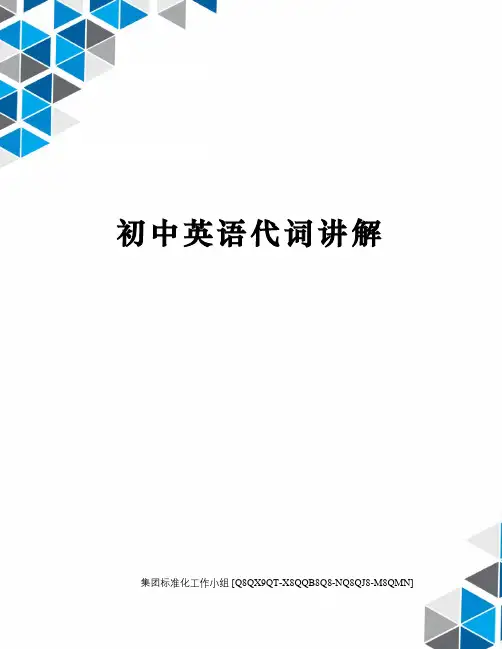
初中英语代词讲解集团标准化工作小组 [Q8QX9QT-X8QQB8Q8-NQ8QJ8-M8QMN]第三章代词:代词的分类:英语中代词分为:人称代词、物主代词、反身代词、指示代词、关系代词、疑问代词、连接代词和不定代词等等。
第一节人称代词、物主代词、反身代词1、人称代词:人称代词代替人和事物的名称,分为主格和宾格两种形式。
(1)、主格用来作句子的主语、表语。
如:I often go shopping on Sundays.(星期天我常去购物) / Are they from Brazil?(他们是巴西人吗?) / Where have they gone?(他们上哪儿去了?) / That’s it.(就那么回事) / It’s he!(是他!)(2)、宾格用来作及物动词或者介词的宾语。
如:Who teaches you English this year?(今年谁教你们的英语?) / Help me!(救救我!) / We oftenwrite letters to her.(我们常给他写信)(3)、人称代词作表语或者放在比较状语从句连词than或as之后时,可以用主格形式,也可以用宾格形式,口语中大多用宾格。
如:--Who is it?(是谁?)–It’s I/me.(是我。
)(4)、三个不同人称同时出现,或者主语中包含“我”时,按照“you→he→I”的顺序表达。
如:Both he and I are working at that computer company.(我和他都在那家电脑公司上班) –Who will go there?(谁要去那儿?) –You and me.(你和我)(5)、人称代词it除了可以指人指物之外,还可以表示“时间、天气、温度、距离、情况”等含义,此外还可以作“非人称代词”使用,替代作主语或者宾语的不定式、动名词或者名词性从句。
如:--What’s the weather like today?(今天天气怎样?)—It’s fine.(天气晴好) / --What’s the time?(几点啦?)–It’s 12:00.(12点) / It’s a long way to go.(那可要走好长的路) / It took him threedays to clean his house.(打扫屋子花了他三天的时间) / It is very clearthat the public want to know when these men can go into space.(很显然,公众想知道这些人什么时候能进入太空) / We found it very difficult to learn a foreign language well.(我们发觉要学好一门外语是非常困难的)2、物主代词:说明事物所属关系的代词,分为形容词性和名词性两种。
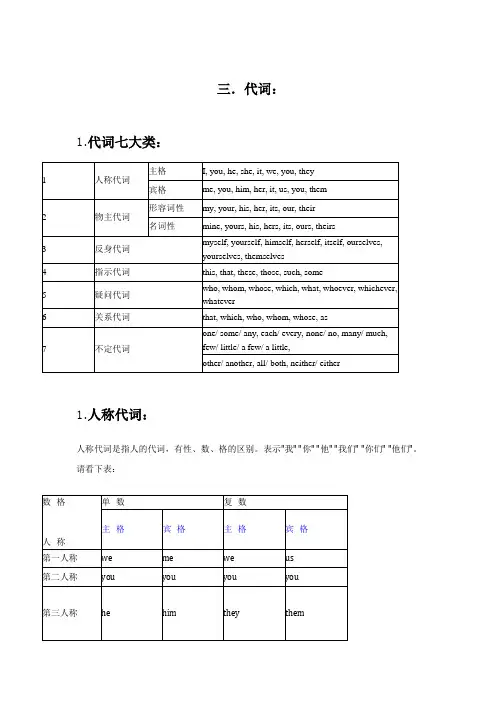
三.代词:1.代词七大类:1人称代词主格I, you, he, she, it, we, you, they宾格me, you, him, her, it, us, you, them2物主代词形容词性my, your, his, her, its, our, their名词性mine, yours, his, hers, its, ours, theirs3反身代词myself, yourself, himself, herself, itself, ourselves, yourselves, themselves4指示代词this, that, these, those, such, some5疑问代词who, whom, whose, which, what, whoever, whichever, whatever6关系代词that, which, who, whom, whose, as7不定代词one/ some/ any, each/ every, none/ no, many/ much, few/ little/ a few/ a little,other/ another, all/ both, neither/ either1.人称代词:人称代词是指人的代词,有性、数、格的区别。
表示"我" "你" "他" "我们" "你们" "他们"。
请看下表:数格人称单数复数主格宾格主格宾格第一人称we me we us第二人称you you you you 第三人称he him they themshe herit it(1)人称代词主格在句中作主语。
例如:She is my English teacher.(2)宾格在句中作宾语。
例如:They don't want me to go there alone.Don't worry. I can look after her.(3)宾格还可以作宾格。

中考英语语法知识讲解一、代词分类及位置(一)代词定义代词是代替名词以及起名词作用的短语、分词和句子的词。
代词是一种功能词,它在句子中起指代和修饰(限定)的作用。
如:This is Miss.Wang.这是王老师。
She is a good teacher.她是一名好老师。
(she代替上文的Miss.Wang)(二)分类1.人称代词:I, you, him, we等2.物主代词:my, her, ours等3.反身代词:myself, themselves等4.指示代词:this, these等5.相互代词:each other等6.不定代词:something, nobody等7.疑问代词:who, what, which等8.连接代词:which, that等9.关系代词:when, which等(三)句中位置1.句首作主语:This is a cute boy.这是一个可爱的女孩。
2.动词后作宾语:Please give me a book. 请给我一本书。
3.名词前作定语:This is my watch.这是我的手表。
4.名词前表限定:There are some books there.那有一些书。
5.系动词后做表语:This watch is mine.这个手表是我的。
二、人称代词(二)人称代词的功能1)主格代词常作主语,宾格代词常作动词或介词的宾语。
Eg: I like playing football.( I在句中作主语)我喜欢踢足球。
You can ask me for advice.( me在句中作ask宾语)你可以向我咨询建议。
2)宾格代词有时可代替主格代词在比较级中,在不引起误解的前提下,有时用宾格代词代替主格代词(尤其是其后跟有同位语all时).Eg: He is taller than us all.他比我们都高。
在情景对话中,当省去谓语时Eg: --Who can drive a bus? -- Me.-- 谁会开公交车?-- 我。


初中英语语法代词讲解文档编制序号:[KKIDT-LLE0828-LLETD298-POI08]初中英语语法代词代词:为了避免重复而用来代替其他词的词。
种类:1) 人称 2) 物主 3) 反身4) 指示 5)不定6) 疑问7) 相互代词:each other, one another互相,其所有格加-’s8) 关系代词:which, who,that,whom,whose等引导定语从句9) 连接代词:who, whom, whose, what, which, whatever, whichever, whoever, whomever10)替代词:one(单数), ones(复数)用于替代前面出现的同类事物。
但ones必须和形容词连用。
如果替代的名词时无形容词在前,则用some, any,而不用ones。
如:Have you bought any rulers Yes,I 've bought some.一、人称代词1.人称代词的形式2.人称代词的句法功能3.人称代词的排列顺序(单数231,复数123)当两个以上的人称代词一起作主语时,单数按二、三、一人称排列(即you, he / she, I);复数按一、二、三人称排列(即we, you, they)。
但是如果做错了事需要承担责任时,要把说话人(I)放在第一位。
如:It was I and John that made her angry. 是我和约翰惹她生气了。
二、物主代词1.物主代词的形式2.物主代词的基本用法3.物主代词的特殊用法在双重所有格中只能用名词性物主代词。
如:我的一个朋友a friend of mine ,她的一个同学 a classmate of hers , each brother of his.三、反身代词1.反身代词的形式反身代词又叫自身代词,表示动作返回到动作发出者本身。
2.反身代词的句法功能3.由反身代词构成的习惯用语①help oneself to 随便吃……②come to oneself 苏醒过来,醒悟,恢复知觉③dress oneself 自己穿衣服④say to oneself 自言自语⑤enjoy oneself 玩得开心⑥lose oneself in迷路于,全神贯注于…之中,消失于⑦teach oneself 自学⑧look after oneself ⑨by oneself 亲自learn……by oneself 自学…leave one by oneself 把某人单独留下hurt oneself 伤了自己make yourself/yourselves at home 不必拘束四、指示代词1. that 用来代替前面提到的不可数名词,those代替复数名词。
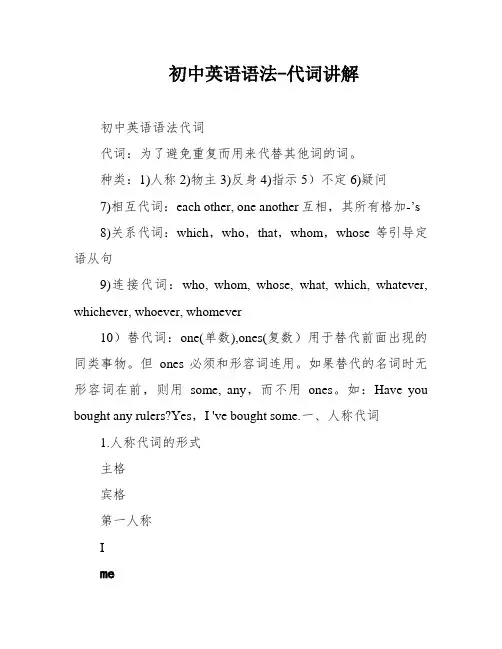
初中英语语法-代词讲解初中英语语法代词代词:为了避免重复而用来代替其他词的词。
种类:1)人称2)物主3)反身4)指示5)不定6)疑问7)相互代词:each other, one another互相,其所有格加-’s8)关系代词:which,who,that,whom,whose等引导定语从句9)连接代词:who, whom, whose, what, which, whatever, whichever, whoever, whomever10)替代词:one(单数),ones(复数)用于替代前面出现的同类事物。
但ones必须和形容词连用。
如果替代的名词时无形容词在前,则用some, any,而不用ones。
如:Have you bought any rulers?Yes,I 've bought some.一、人称代词1.人称代词的形式主格宾格第一人称Ime功能主格作主语作动词宾语宾格作介词宾语作表语指时间指天气指间隔单数第二人称youyouhehim第三人称sheheritit例句Theyare fourteen years old. /Sheis a Chinese teacher. The box is too heavy. Let me helpyou. / I likeitvery much. Mary didn’t want to go withme.--- Who is standing over there?---It’sme.Itis early spring, but it’s already very hot.Itrained ________________(大)last night.复数第一weus第二youyou第三theythem2.人称代词的句法功用It’s about five ___________(minute)walk from here to the library.How far is it from your school to your home?I finditeasy to learn English well.-Where’s my book?-It’s over there.it的特殊用法作方式主语、Itis very nice of you to help me.方式宾语指前文提到的物指不知性别的婴儿或不确指性此外人The baby is crying. It may be hungry.3.人称代词的布列按次(单数231,复数123)当两个以上的人称代词一同作主语时,单数按2、3、一人称布列(即you, he / she, I);复数按1、2、三人称布列(即we, you, they)。
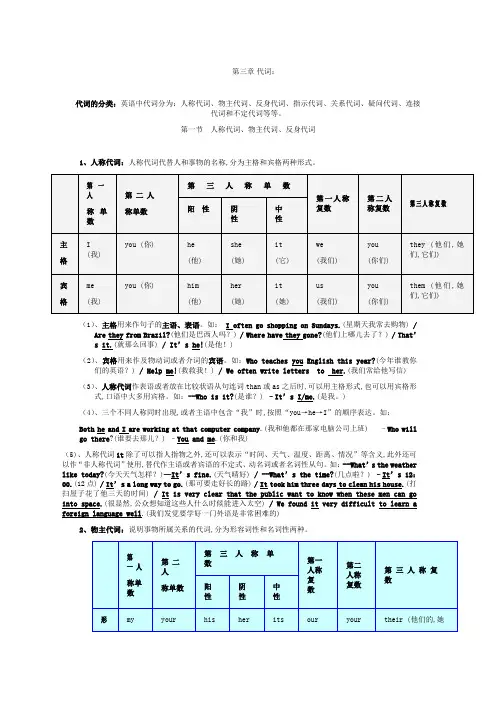
第三章 代词:代词的分类:英语中代词分为:人称代词、物主代词、反身代词、指示代词、关系代词、疑问代词、连接代词和不定代词等等。
第一节 人称代词、物主代词、反身代词1、人称代词:人称代词代替人和事物的名称,分为主格和宾格两种形式。
(1)、主格用来作句子的主语、表语。
如: I often go shopping on Sundays.(星期天我常去购物) /Are they from Brazil?(他们是巴西人吗?) / Where have they gone?(他们上哪儿去了?) / That ’s it.(就那么回事) / It ’s he!(是他!) (2)、宾格用来作及物动词或者介词的宾语。
如:Who teaches you English this year?(今年谁教你们的英语?) / Help me!(救救我!) / We often write letters to her.(我们常给他写信) (3)、人称代词作表语或者放在比较状语从句连词than 或as 之后时,可以用主格形式,也可以用宾格形式,口语中大多用宾格。
如:--Who is it?(是谁?) –It ’s I/me.(是我。
) (4)、三个不同人称同时出现,或者主语中包含“我”时,按照“you →he →I ”的顺序表达。
如: Both he and I are working at that computer company .(我和他都在那家电脑公司上班) –Who will go there ?(谁要去那儿?) –You and me .(你和我)(5)、人称代词it 除了可以指人指物之外,还可以表示“时间、天气、温度、距离、情况”等含义,此外还可以作“非人称代词”使用,替代作主语或者宾语的不定式、动名词或者名词性从句。
如:--What ’s the weather like today?(今天天气怎样?)—It ’s fine.(天气晴好) / --What ’s the time?(几点啦?) –It ’s 12:00.(12点) / It ’s a long way to go.(那可要走好长的路) / It took him three days to clean his house.(打扫屋子花了他三天的时间) / It is very clear that the public want to know when these men can go into space.(很显然,公众想知道这些人什么时候能进入太空) / We found it very difficult to learn a foreign language well .(我们发觉要学好一门外语是非常困难的)2、物主代词:说明事物所属关系的代词,分为形容词性和名词性两种。
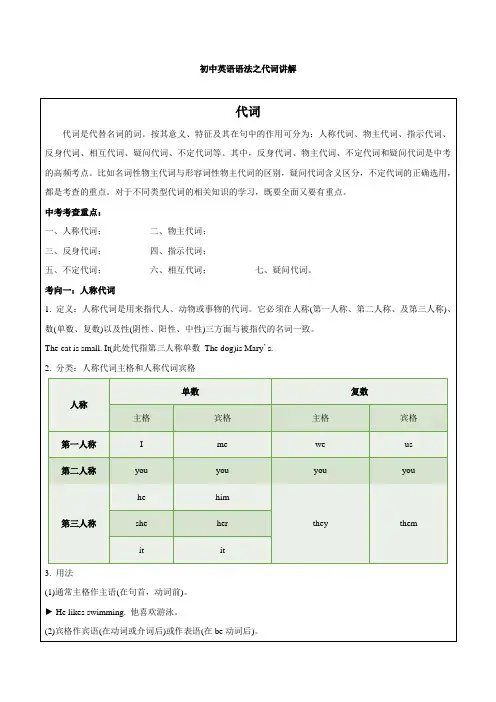
初中英语语法之代词讲解2. 用于询问天气或品行:What be+主语+like?► What’ s the weather like? 天气怎么样?3. 用于询问外貌、长相:What do/does/did+主语+look like?► What does she look like? 她长什么样?4. 征求对方的意见:What about ...?► What about going out for a movie? 出去看电影怎么样?—____________ are you going to buy for your father for Father’ s Day?—A T-shirt.A. WhatB. WhenC. WhereD. How【答案】A【解析】分析句子结构可知,空处要填的疑问词作动词buy的宾语,选项中只有A项可以作宾语。
故选A。
1. —Have you found your lost mobile phone?—No, I haven’t found ____________, but I bought ____________ this morning.A. one;thatB. that;oneC. it;oneD. one;it2. She got up to get some sleeping pills but found there was ____________ left at home.A. nothingB. noneC. somethingD. nobody3. —Mike, where’s today’s newspaper?—Well, you don’t need to read it because there is ____________ in it.A. something interestingB. nothing specialC. important thingD. anything new4. —Let’s go to see a film this weekend, can we go on Saturday or Sunday?—____________ is OK. I’ m not free at weekends.A. NeitherB. EitherC. EveryD. Each5. The song I Believe I Can Fly tells us that believing in ____________ is very important.A. themselvesB. itselfC. ourselvesD. yourselves6. My dad is my role model. I learn a lot from ____________.A. itB. himC. herD. them1. C 【解析】句意:——你找到你丢失的手机了吗?——没有找到,但是今天上午我买了一个新的。
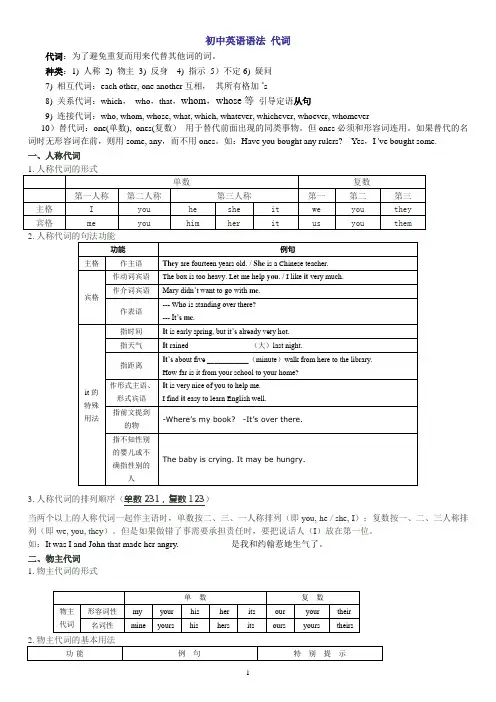
初中英语语法代词代词:为了避免重复而用来代替其他词的词。
种类:1) 人称2) 物主3) 反身4) 指示5)不定6) 疑问7) 相互代词:each other, one another互相,其所有格加-’s8) 关系代词:which,who,that,whom,whose等引导定语从句9) 连接代词:who, whom, whose, what, which, whatever, whichever, whoever, whomever10)替代词:one(单数), ones(复数)用于替代前面出现的同类事物。
但ones必须和形容词连用。
如果替代的名词时无形容词在前,则用some, any,而不用ones。
如:Have you bought any rulers?Yes,I 've bought some.一、人称代词2.3. 人称代词的排列顺序(单数231,复数123)当两个以上的人称代词一起作主语时,单数按二、三、一人称排列(即you, he / she, I);复数按一、二、三人称排列(即we, you, they)。
但是如果做错了事需要承担责任时,要把说话人(I)放在第一位。
如:It was I and John that made her angry. 是我和约翰惹她生气了。
二、物主代词1. 物主代词的形式2. 物主代词的基本用法3. 物主代词的特殊用法在双重所有格中只能用名词性物主代词。
如:我的一个朋友a friend of mine , 她的一个同学a classmate of hers , each brother of his.三、反身代词1. 反身代词的形式2. 反身代词的句法功能3.由反身代词构成的习惯用语① help oneself to 随便吃……② come to oneself 苏醒过来,醒悟,恢复知觉③ dress oneself 自己穿衣服④ say to oneself 自言自语⑤ enjoy oneself 玩得开心⑥ lose oneself in迷路于,全神贯注于…之中,消失于⑦ teach oneself 自学⑧ look after oneself ⑨by oneself 亲自learn……by oneself 自学…leave one by oneself 把某人单独留下hurt oneself 伤了自己make yourself/yourselves at home 不必拘束四、指示代词1. that 用来代替前面提到的不可数名词,those代替复数名词。
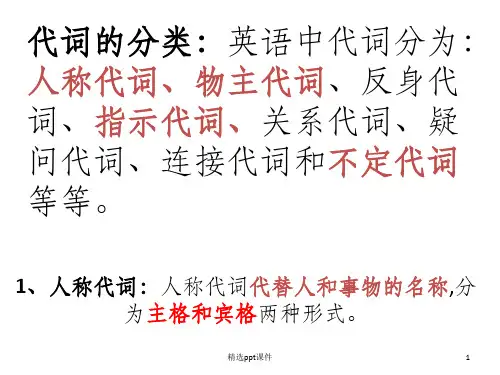
中考英语语法复习代词知识讲解代词是代替名词以及起名词作用的词,大多数代词具有名词和形容词的功能。
一、人称代词、物主代词、反身代词1)人称代词的主格作主语,一般用于动词前。
例句:They have many legs.它们有很多条腿。
2)人称代词的宾格做宾语,通常跟在及物动词或介词后面,也就是我们通常所说的“动宾”和“介宾”。
例句:Let me buy the tickets first.让我先买票。
(let是动词,动宾)I sometimes play badminton with her.(with 是介词,介宾)3)形容词性物主代词在句中作定语,后面必须跟名词。
例句:Put it on her desk.把它放在她的桌子上.(her后面跟的名词desk)These are my family and relatives.这些是我的家人和亲戚。
(my后面跟的是名词family和relatives)4)名词性物主代词用作主、宾、表语,不能与名词连用,相当于“形容词物主代词+名词”。
例句:Those shoes are ours.那些鞋子是我们的。
Mine is the biggest and the most beautiful.我的最大最漂亮。
(句中的ours 和 mine后面都没有名词,所以要用名词性物主代词)5)反身代词在剧中做宾语,起强调作用。
例句:I can sweep the floor (by) myself.我可以自己扫地。
(myself在句中起强调作用,可以在前面加by,也可以不加)6)反身代词的固定搭配help oneself to 随便吃enjoy oneself 玩的开心teach oneself 自学by oneself 亲自例句:Help yourselves to the cakes,children.孩子们,这些蛋糕你们随便吃My brother usually teaches himself Japanese.我哥哥通常自学日语。
初中英语代词知识点总结讲解表示三者或三者以上中的其他。
① Another表示“另一个,再一个”,常用于单数可数名词前。
例如:Can I have another piece of cake?5)指示代词①this表示“这个”,用于近处的人或物;①that表示“那个”,用于远处的人或物;①these表示“这些”,用于近处的人或物的复数;①those表示“那些”,用于远处的人或物的复数。
6)关系代词①who指人,作主语或宾语;①whom指人,作宾语;①whose指人或物,作定语;①which指物,作主语或宾语;①that指人或物,作主语或宾语。
7)疑问代词①what指事物;①which指人或物;①who指人;①whom指人,作宾语;①whose指人或物,作定语。
总结:代词是英语中不可或缺的一部分,掌握好代词的用法对于我们的英语研究和日常交流都有很大的帮助。
以上就是初中英语代词知识点的总结讲解,希望对大家有所帮助。
A。
some other2.I've finished reading this book。
do you have __________ ones?A。
XXXA。
any other3.She didn't like the red dress。
so she tried on __________ one.XXXA。
another4.He has __________ friends。
but he only invited a few to his party.A。
many otherB。
some otherC。
any otherD。
no otherA。
many other5.There is __________ milk left in the bottle。
can you buy some more?A。
XXXA。
little2.Some people like to stay at home on Sundays。
Grammar: 学习目标1. 复习人称代词的主格、宾格;2. 掌握形容词性、名词性物主代词的用法;3. 掌握重点不定代词的用法;精讲提升(1)人称代词①人称代词作主语时用主格,作宾语时用宾格:He (主语) is a great writer.They all like him(宾语)very much.②she可以用来代表国家,船只,大地,月亮等:China loves her people.③在并列的主语中,I 总放在最后:Xiao Y u and I are good friends.(2)物主代词①形容词型的物主代词只能作定语,如:my brother.②名词型的物主代词有充当名词的作用:Whose dictionary is this? ------ It’s mine.Ours is a big family.You may use my pen. I’ll use hers.(3) 反身代词I can’t express (表达) myself in English.That poor boy was myself.重要补充:① 为了强调语气,表示“亲自”。
如:He says he’ll do it himself.① 反身代词常和某些动词连用,如:I hope you’ll enjoy yourselves. 希望你们玩得开心。
Please help yourself to some fish. 请吃点鱼。
(4)不定代词Some/any:① some用于陈述句中;any用于疑问句和否定句。
① same也用在“请求、建议、反问”等含义的疑问句中,以期待得到对方肯定的回答。
Would you want some coffee?Didn’t he give you some books? 难道他没有给你一些书?Both/all① both表示“两者都”;both A and B① all表示“所有都”,三者或三者以上Other与another① Other具有代词和形容词性质,即可指人,也可指物。